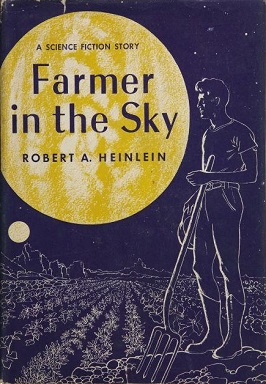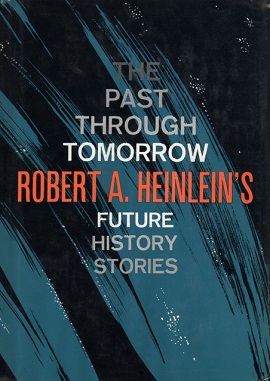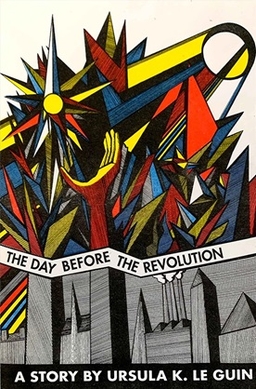
Robert Anson Heinlein was an American science fiction author, aeronautical engineer, and naval officer. Sometimes called the "dean of science fiction writers", he was among the first to emphasize scientific accuracy in his fiction, and was thus a pioneer of the subgenre of hard science fiction. His published works, both fiction and non-fiction, express admiration for competence and emphasize the value of critical thinking. His plots often posed provocative situations which challenged conventional social mores. His work continues to have an influence on the science-fiction genre, and on modern culture more generally.

Starship Troopers is a military science fiction novel by American writer Robert A. Heinlein. Written in a few weeks in reaction to the US suspending nuclear tests, the story was first published as a two-part serial in The Magazine of Fantasy & Science Fiction as Starship Soldier, and published as a book by G. P. Putnam's Sons on November 5, 1959.

The Moon Is a Harsh Mistress is a 1966 science fiction novel by American writer Robert A. Heinlein about a lunar colony's revolt against absentee rule from Earth. The novel illustrates and discusses libertarian ideals. It is respected for its credible presentation of a comprehensively imagined future human society on both the Earth and the Moon.

Farmer In The Sky is a 1950 science fiction novel by American writer Robert A. Heinlein about a teenaged boy who emigrates with his family to Jupiter's moon Ganymede, which is in the process of being terraformed. Among Heinlein's juveniles, a condensed version of the novel was published in serial form in Boys' Life magazine, under the title "Satellite Scout". The novel was awarded a Retro Hugo in 2001.
"Misfit" is a science fiction short story by American writer Robert A. Heinlein. It was originally titled "Cosmic Construction Corps" before being renamed by the editor John W. Campbell and published in the November 1939 issue of Astounding Science Fiction. "Misfit" was Heinlein's second published story. One of the earliest of Heinlein's Future History stories, it was later included in the collections Revolt in 2100 and The Past Through Tomorrow.
"The Green Hills of Earth" is a science fiction short story by American writer Robert A. Heinlein. One of his Future History stories, the short story originally appeared in The Saturday Evening Post, and it was collected in The Green Hills of Earth. Heinlein selected the story for inclusion in the 1949 anthology My Best Science Fiction Story. "The Green Hills of Earth" is also the title of a song mentioned in several of Heinlein's novels.
"The Menace From Earth" is a science fiction short story by American writer Robert A. Heinlein, first published in the August 1957 issue of The Magazine of Fantasy & Science Fiction.

The Green Hills of Earth is a collection of science fiction short stories by American writer Robert A. Heinlein, published in 1951, including short stories published as early as 1941. The stories are part of Heinlein's Future History. The title story is the tale of an old space mariner reflecting upon his planet of birth. According to an acknowledgement at the beginning of the book, the phrase "the green hills of Earth" is derived from a story by C. L. Moore.
George Edgar Slusser was an American scholar, professor and writer. Slusser was a well-known science fiction critic. A professor emeritus of comparative literature at University of California, Riverside, he was the first curator of the Eaton collection.

The Past Through Tomorrow is a collection of science fiction stories by American writer Robert A. Heinlein, first published in 1967, all part of his Future History.

Destination Moon is a 1950 American Technicolor science fiction film, independently produced by George Pal and directed by Irving Pichel, that stars John Archer, Warner Anderson, Tom Powers, and Dick Wesson. The film was distributed in the United States and the United Kingdom by Eagle-Lion Classics.
The exploration of politics in science fiction is arguably older than the identification of the genre. One of the earliest works of modern science fiction, H. G. Wells’ The Time Machine, is an extrapolation of the class structure of the United Kingdom of his time, an extreme form of social Darwinism; during tens of thousands of years, human beings have evolved into two different species based on their social class.
"Space Jockey" is a science fiction short story by American writer Robert A. Heinlein. Part of his Future History series, it originally appeared in The Saturday Evening Post, April 26, 1947, and was collected in The Green Hills of Earth.
The science fiction writer Robert A. Heinlein (1907–1988) was productive during a writing career that spanned the last 49 years of his life; the Robert A. Heinlein bibliography includes 32 novels, 59 short stories and 16 collections published during his life. Four films, two TV series, several episodes of a radio series, at least two songs and a board game derive more or less directly from his work. He wrote the screenplay for Destination Moon (1950). Heinlein also edited an anthology of other writers' science fiction short stories.
The Heinlein juveniles are the science-fiction novels written by Robert A. Heinlein for Scribner's young-adult line. Each features "a young male protagonist entering the adult world of conflict, decisions, and responsibilities." Together, they tell a loosely connected story of space exploration. Scribner's published the first 12 between 1947 and 1958, but rejected the 13th, Starship Troopers. That one was instead published by Putnam. A 14th novel, Podkayne of Mars, is sometimes listed as a "Heinlein juvenile", although Heinlein himself did not consider it to be one.
"Nothing Ever Happens on the Moon" is a science fiction short story by American writer Robert A. Heinlein, published in April and May 1949 in Boys' Life, a magazine of the Boy Scouts of America, who jointly hold copyright with Heinlein, dated 1976. The story is about a boy who tries to become an Eagle Scout on the Moon. It is approximately 30 pages long as collected in Expanded Universe (1980). The story was again collected in Off the Main Sequence (2005).
Space warfare is main theme and central setting of science fiction that can trace its roots back to classical times, and to the "future war" novels of the 19th century. With the Modern Age, directly with franchises as Star Wars and Star Trek, it is considered one of the most popular general sub-genres and themes of science fiction. An interplanetary, or more often an interstellar or intergalactic war, has become a staple plot device. Space warfare, represented in science fiction, has a predominant role, it is a central theme and at the same time it is considered parent, overlapping genre of space opera, military science fiction and Space Western.

"The Day Before the Revolution" is a science fiction short story by American writer Ursula K. Le Guin. First published in Galaxy in August 1974, it was anthologized in Le Guin's 1975 collection The Wind's Twelve Quarters and in several subsequent collections. Set in the fictional Hainish universe created by Le Guin, the story has strong connections to her novel The Dispossessed, and is sometimes referred to as a prologue to the longer work, though it was written later.

Fran Van Cleave is an American author of libertarian science fiction, born in Boston and educated as a pharmacist. She was an active member of the Libertarian Futurist Society for many years and served as director of the society in 2005. Van Cleave's works include adventure stories with young protagonists, influenced by the Heinlein juveniles. In addition to fiction, Van Cleave has published articles on scientific topics in Analog Science Fiction and Fact.









